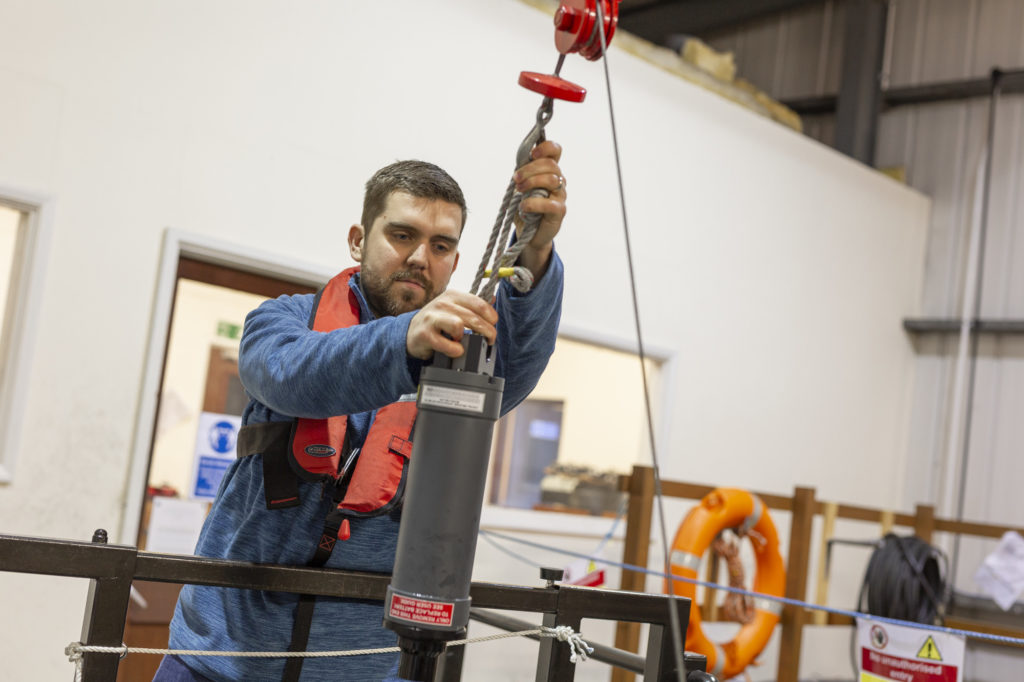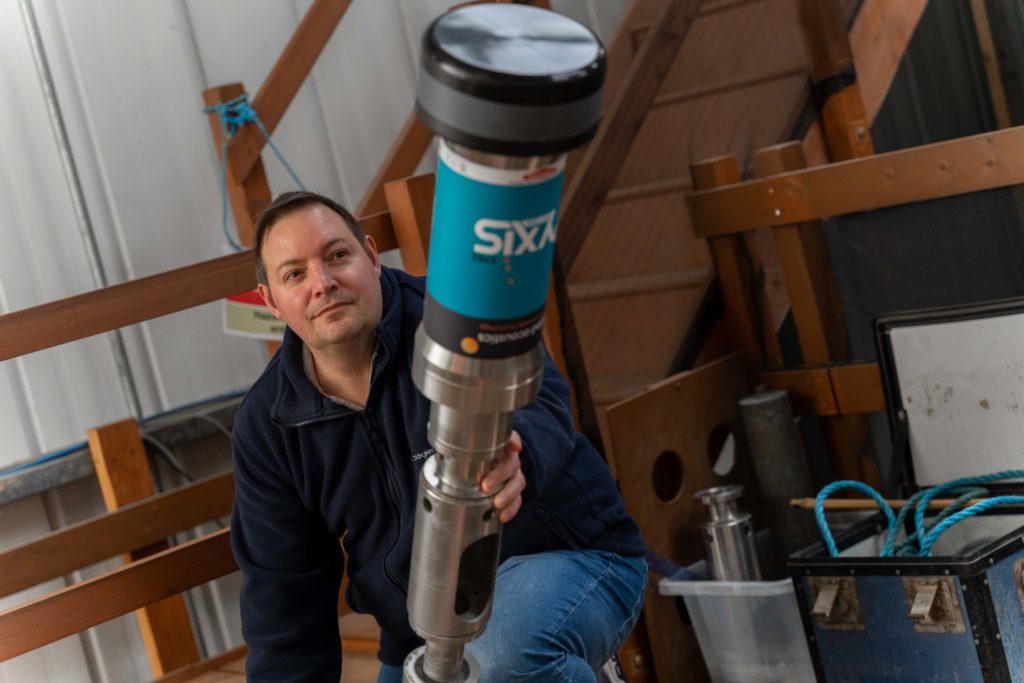‘I love being in the thick of everything going on here.’ A spotlight on Jamie Higginbotham

In many ways, Jamie is aae technologies’ best-kept secret. Rarely having direct contact with customers, and strangely absent from our website’s team pages, he’s been playing a key role in our workshops for many years. Doing everything from writing software to drilling holes, refining our testing processes and constantly exploring the best ways to get things done, he uses every one of his diverse skills on a daily basis.
Jamie took time out from his duties as Production Supervisor to talk over the highlights of his time here at aae technologies and how his work has evolved since joining us in 1999.
How would you describe your role at aae technologies?
It’s now looking after the acoustic positioning product range. So, I could be doing anything from advising one of our engineers on what to do, to putting products together myself.
We’ve recently split production into tiers, separating our sub-bottom profiling product line from our acoustic positioning product range, which includes all of our positioning and release beacons, and our Easytrak USBL systems. I look after the acoustic positioning product range, while Rob Whiting handles the sub-bottom profiling production.
What brought you to joining aae?
Twenty-something years ago, I did a work placement at another local undersea technology company called GeoAcoustics for around 18 months. When I’d finished my HND, I was then looking for a job and sent my CV around to a few similar companies, one of which was aae.
My thinking was, I knew the area (both locally speaking and in terms of the industry) and could work here for a while until I found my ‘dream job’. Someone at GeoAcoustics vouched for me and helped me get in the door. That was in August 1999. Since then, I’ve stayed here for over 23 years – it must have been my dream job after all!
Did you have a previous interest in subsea technology?
Coming through the education system, I did an OND in engineering, which involved both mechanical and electronic engineering. This was all locally – the OND was at Great Yarmouth College and then the HND at Norwich City College. I always thought I wanted to go into the CAD (computer aided design) side of things, but found myself getting into the electronics side and it kind of went from there.
How has your career changed or progressed since joining?
So, I started as a trainee, working on subsea equipment assembly for around one or two years. I then progressed to a test engineer role, and after five years then to senior test engineer where I basically ended up looking after all the test fixtures. It’s now so long ago, it’s tricky to remember! From there it’s progressed again more recently to the production side, and supervision.
How do you feel aae has changed in that time?
When I started, the company had around ten members of staff, and we’re now up to around 50, so there’s been a marked amount of growth. When you’ve been here for as long as I have, you do start to feel a vested interest in the business, and it’s been a real pleasure watching it grow from a small company to where we are now.
Twenty-three years ago, we were at the smaller Faraday Way site, literally only 500 yards away. We might not have moved very far distance-wise since I’ve been here, but as a company we’ve taken enormous leaps and bounds. I’ve been through two moves of premises, and each time the building has gotten twice as big.
What’s been your biggest highlight or achievement so far?
Probably the whole tank testing process that we do with the beacons. I’ve taken it from what it was when I started to something far more automated.
We originally had a calculator and a piece of paper, and would manually work out all the calculations for what we were measuring in the tank. Now it’s all done by computer – you can leave it for twenty minutes and it’s all done for you when you come back. It’s gone from an hour test with constant monitoring to a twenty-minute test that is click-and-forget.
To be honest, the real achievement was actually getting the company to agree to the software. It was a three-year progression, which started with saying ‘if we invest this amount, this is what we can do.’ At the time, it was a big investment for us on software but I think it paid for itself after three years in terms of the amount of time and labour that we’ve saved. We basically cut the time for testing down to a third of what it was. That’s probably my biggest achievement.

Is it true to say technology has driven the evolution of the business?
When I started there were just four computers in the entire company. And now every person in the company has at least one device, as well as all the shared terminals for testing. The improvements in technology are visible in the products as well. There are things we do now that we couldn’t have done twenty years ago, especially thanks to miniaturisation in what you can do in the integrated circuit (IC) or microchip.
When I first started, it was literally an eprom and analogue electronics, but that role is now performed by a microcontroller or ARM chip. Where it was once all analogue electronics, it’s now all done digitally. It’s really hard to describe the change, as it’s something you can’t see, it’s all done in a little black device. But it makes a big difference.
What’s been your biggest challenge?
I guess it’s been learning to have the patience to let people agree with your opinion – or not! I’m quite opinionated, and because I’ve been here for years, I believe there is a certain way of doing things. I will share my opinion, but obviously there is a structure involved and you have to be happy to let people who have more of an idea of what to do have their opinion too.
I might disagree over how something is done, but you need to trust others with their plan and follow it. You have to believe that the person you’re working with knows what they’re doing, and that you don’t always know best. On a personal level, that’s my biggest challenge.
In a team environment, with collaboration, you always need to find the middle ground and come to an agreement. Or you can give someone else’s way a try. You can always say ‘I told you so’ at the end, but there’s no point in making things more difficult than they need to be. Sometimes the only way to know for sure is to test.
This said, I can’t think of any occasions where we’ve done something that I’ve really disagreed with and it’s gone wrong!
“I love the variety of what I do. One day I could be drilling holes in a box, another day writing software or fault-finding, trying to find problems with an item.”

What’s your usual day like?
On a good day, I’ll come in, check emails, check that everyone in the team is OK and then I won’t hear anything. Everything will just proceed as normal in terms of production and testing.
On a bad day, I’ll come in, check emails and then get a million and one problems. And then you’re in problem-solving mode for the rest of the day. But that’s the good thing about what I’m doing now – no two days are the same.
Problems vary from a small scratch on a casing to needing to replace the unit to even ‘this whole thing’s on fire, what do we do?’. That did happen, but only once! There was a short-circuit on one of the test units, so we got it outside ASAP! Nothing like that has ever happened with any finished products, though.
Otherwise, everything I do is workshop-based – due to my knowledge and skill set – and I enjoy being in the thick of what’s going on there.
What do you love most about your job?
The variety of things I get to do. One day, I could be drilling holes in a box, another I could be writing software or fault-finding, trying to find problems with an item. Quite a range of activities.
This probably grows from my college experience. Back then everyone was encouraged to try a bit of everything. It seems now that colleges don’t want to do that. We’ll have conversations with people who are just out of college who maybe have done a particular engineering course but haven’t done any modules on fault-finding or even basic engineering skills like using a drill. That might be an exaggeration, but everything seems very PC-based rather than practical, which may in part be down to how health and safety in training has changed over the last twenty years. But I enjoy having a range of skills I can use every day.
What do clients appreciate most about what you do?
I would hope the reliability of it! I don’t personally get direct feedback from clients, but news does filter through from the sales and technical teams if there are issues and something we need to check or change in our processes. It’s always good to know where we can improve anything.
What are you excited about for the future?
We have some very exciting new products coming out – some I can talk about and others I can’t yet! Obviously Pyxis is a big one for us, and much talked about, but there is some very interesting stuff in the pipeline that could be potentially game-changing for us as a company. I’m sure it’ll all be announced in due course!
In the meantime, I’m looking forward to the team growing. We took on two new production staff during the last four months and I expect over the summer at least one more will be added.
It could be that we’ll see more women coming into the industry. We’ve now got two women working in production, and I know there’s another applying for a work placement with us, so there are definitely more women coming through than 20 years ago. And it does feel more open than it was.
Looking to upgrade your subsea equipment?
Check out our latest range of sensors, beacons, transponders, USBL systems, workstations and more…






